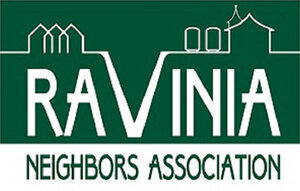A History, Should We Forget Our Fire
By Amy Lohmolder
Several months ago, at an RNA meeting, one of our members noted that it is often the absence of pressing issues at any given time that causes us to fumble, wondering at our agenda. Who are we as a community group when we are not fighting for city support or monitoring and shaping developments in our neighborhood? What do we do at these times?
I wondered how those who first shaped the Ravinia community had regarded this issue of purpose. What kinds of things did they do? What did they hope to accomplish together? Julia Johnas of the Highland Park Library was extremely helpful in digging up archival information.
The earliest dated material obtained, a clipping from the Chicago Daily News, dated Aug. 2, 1913, reads: “A year ago Ravinia, the most verdant and forest-like suburb on the North Shore, was a village of 70 householders. Each unit of the village was perhaps an artist, a manufacturer, a lawyer or a capitalist. The personnel of the village was remarkable, but somehow each person entertained only a bowing acquaintance with his fellow.” At a pivotal meeting, one resident, Mrs. Robert R. Greig, was quoted as saying “Ravinia has no civic pride. We need a community house. We must get acquainted.”
The article goes on to tell of how the residents marched forward. The women dragged the men into the venture and committees were formed. Each of the 70 householders pledged to earn $10 for the cause by work outside their regular vocation. The second issue of a witty campaign rag, The Stimulator, “Published by the Calsomine Committee as seldom as town business will permit” and bylined “Roger Williams” cajoled neighbors along, giving the latest on donated items for sale: “Big Chief F.(ly) R.(emover) Bott has peddled 9 dozen peerless swatters and only has a few left at two for two bits.” Many of the residents offered pragmatic goods and services: berry harvesting, swimming lessons, apron making, maple syrup tapping, vegetable growing, baking, child care, camera snapshots and “taxi services” in an electric brougham. Others looked to talents like water-color sketching, lecturing, storytelling, musical presentations and astrological readings to make their contributions.
Some fun-loving neighbors sought to come up with the best “stunt” to raise money: serenades (the crooners were paid to “vamoose”), winter water drenchings (40 Lake Michigan buckets dumped over “heroic” Fred D. Porter at 25 cents each) and some mock hold-ups with a lead pipe that nearly got fundraiser G. W. Carr arrested! In the end, $900 was raised to renovate the old schoolhouse turned into a community house. The dedication and “Lighting of the Fire” was held on Saturday, Nov. 22, 1913.
The Chicago Daily News article relates how the residents saw their project: “the Ravinia community house was to be no ordinary building contributed by the philanthropy of the rich. The planning of the campaign for money was so unique the ‘ends’ of what a community house stands for were first reached in the ‘means’ of raising funds.” These early Ravinia neighbors built more than a building. They built the community -- the community that went on to manage their collective neighborhood needs for years to come -- as well as to host plays, lectures, “feasts of fun and food” and the occasional (men only) “smoker.”
Despite the whirlwind feeling imparted from snippets of news articles and the victorious outcome of their story, librarian Julia Johnas observes that early Ravinia community-making had not been any easier an undertaking than our own attempts at drawing neighbors together. She describes early residents as “busy” and “extremely exclusive.”
The Ravinia Commission’s June 1921 annual meeting minutes, which contains a recounting of their birth in roughly 1913, again acknowledges the initial lack of community spirit, adding: “our lone representative [to the newly joined Highland Park City Council] had a hard time keeping the spark of interest alive.” Another part relates that “Interference in one’s neighbor’s affair was resented and his sewer was his own business.” This initial reluctance to commune with one’s neighbor makes our forebears’ achievement that much more remarkable. In 1912, a commitment to creating “civic pride” ignited a spark. Indeed, Raviniaites lit the “Fire.”
The tale of the “Ravinia Village House,” as it came to be known, and the many social and creative events hosted there over the years, attest to the fact that these early Raviniaites were something more than just determined problem solvers. They remind us of what might be most worthwhile and whom we might be when we don’t know what to do next. There is value in nurturing our neighborhood connections, sharing our more humorous, venturous, creative -- generous impulses, and being part of a vibrant community.
Postscript: What became of the Ravinia Village House?
The Village House endured until at least May of 1930, referenced in a letter penned by K.E. Wagner to Dudley Craft Watson. No later record has been located. Julia Johnas states that the Village House had been built somewhere on Ravinia School grounds. It no longer exists, evidently torn down at some point.

